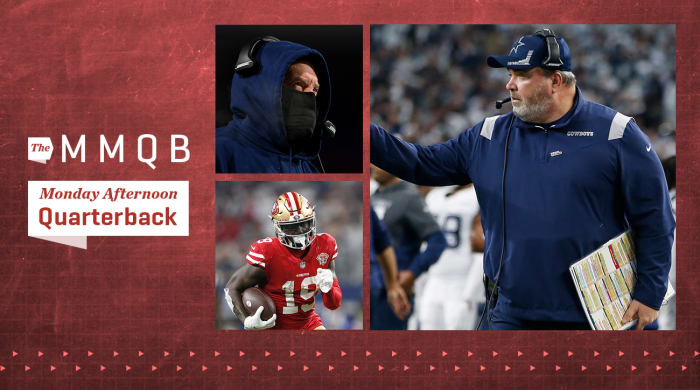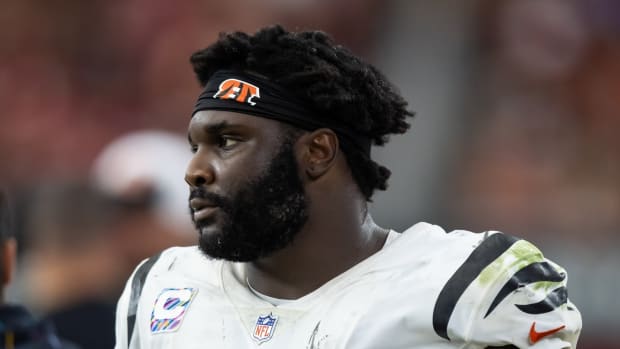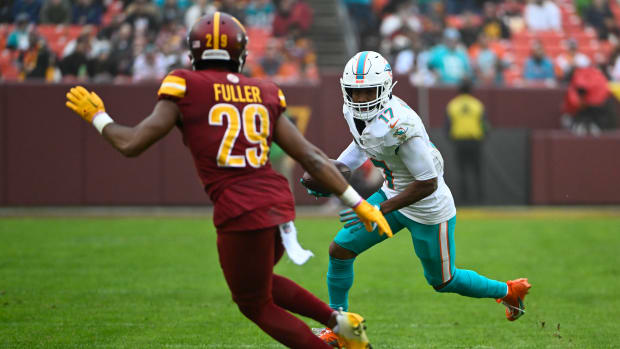MAQB: Analyzing Kellen Moore and Mike McCarthy's Controversial Quarterback Draw
Lots to clean up from wild-card weekend, let’s dive in …

Mike McCarthy (Tim Heitman/USA TODAY Sports), Bill Belichick (Rich Barnes/USA TODAY Sports), Deebo Samuel (Tim Heitman/USA TODAY Sports)
• Let’s start with the Cowboys and the quarterback draw call that’ll go down in infamy—one authored by Kellen Moore and authorized by Mike McCarthy, who defended it after the game as the “right call.” I’ve run this up the flagpole with a few coaches today. There are a few things that I feel comfortable saying. One, if you get the ball clocked, like the Cowboys did, and you’re pushing the ball down the middle of the field, either on the ground or through the air, you’ll need at least 16 seconds, and some teams set their rules at 18 seconds, to get ball clocked again.
“At 14, you’re playing Russian roulette,” said one veteran offensive coach. Two, Dak Prescott and center Tyler Biadasz should be coached in that situation to immediately, upon the previous play’s ending, get the ball to the umpire, because he’s the one who needs to set it before it can be snapped again. And three, some teams in that spot will have a play built in that they can snap the ball to, if there isn’t enough time to clock it. So how’d the Cowboys do? They called the draw with 14 seconds left. Prescott and Biadasz tried to set and snap the ball on their own, actually blocking the umpire from setting it as they did it. And the official gamebook shows that Prescott actually did get the snap off, meaning he could’ve thrown it into the end zone and the play would’ve counted. In the grand scheme of things, this may seem like small stuff. But NFL games, and especially playoff games, are usually won on the margins—meaning situational play (red zone, third down, etc., etc.) is often the difference between winning and losing. It sure was in Arlington on Sunday afternoon.
• While we’re there, there was actually another situation that flew under the radar over the weekend that wasn’t quite as bad, but still merited scrutiny. There was an old football coach named Homer Smith who had a saying about two-minute football—“You either run out of time or you run out of downs.” The point of the adage was, essentially, that coaches should do their best to preserve both as best they can. The Raiders didn’t do that in the most critical spot on Saturday. With 45 seconds left, Derek Carr snapped the ball into third-and-10 at the 19, down 26–19, and hit Zay Jones at the sticks to set up first-and-goal from the 9. He and the offense hurried to the line and spiked it with 30 seconds left, giving them three snaps to score from nine yards out—a challenging situation where you have to throw the ball in a condensed area.
Wouldn’t the Raiders have been better off giving themselves four shots? A story I heard Monday actually explained how Alabama coach Nick Saban handles these situations. He has one-word play calls built in that work regardless of the personnel grouping on the field, so no matter who’s out there, the team can hustle to line and get that extra shot at the end zone. The quarterback’s instructed to be careful for things looking off, because it is a hurry-up situation, but it’s at the very least a way a team can use all four downs in a spot like that, with the worst-case scenario in the way it’s coached (an incompletion) being the same as the spike. Instead of doing it this way, of course, Las Vegas only forced Cincinnati to make three stops, and the Bengals did, so they’re moving on.
• Speaking of the Raiders, I can understand why the team would want to clear the decks and start anew after the way 2021 went. But the handling of the Mike Mayock situation was bizarre. Mayock’s scouting department spent Monday working through free agency and college all-star game assignments, only to see on social media in the afternoon that the Raiders had submitted a request for Patriots exec Dave Ziegler to interview for a GM spot that they didn’t know was open. Obviously, the NFL’s a cold business. And the writing’s been on the wall with Mayock for a while—he didn’t always see eye to eye with ex-coach Jon Gruden, and rumors flew last spring that he could be fired after the draft. It didn’t happen then. It has happened now. But that it went down this way, to me, is just bad business on the part of the Raiders.
• Twelve or so years ago, Patriots coach Bill Belichick, then in his late 50s, told an NFL Films crew shooting his A Football Life documentary, “I won’t be like Marv Levy coaching in my 70s, I know that.” On Monday, at his season-ending press conference, Belichick told reporters that he does, in fact, plan to coach in 2022. “I would say that’s accurate,” he said. And that ensures that he will, in fact, coach into his 70s—he hits the big number on April 16. To be clear, the idea here is not to call Belichick out on having said something more than a decade ago that he’s now going back on. Belichick himself, in fact, said a few years back on Boston radio that his feeling on coaching at that age had changed.
The reason we’re bringing it up? To examine why he keeps going. And I honestly believe the answer is as simple as it’s been for Belichick’s old quarterback, Tom Brady. He still loves it, and there isn’t anything he’d rather do. And there are, indeed, some things that have changed. One, being in one NFL location for as long as he has been doesn’t make it turnkey—no pro football organization works quite that way—but it does make a place more self-sustaining. Simply put, Belichick doesn’t have the same mountain of issues that a guy in his first year, or fifth year, or even 10th year in a place might. Two, because of advancements in technology, it’s easier to do certain aspects of the job remotely, making it easier for a guy like Belichick to do things people in their golden years would want to, while still doing his job. Three, his kids are grown and working for him now, so going to the office also happens to be family time. Belichick’s fond of saying coaching football “beats working” and I really believe he feels that way about. And as long as he can do the job the way he is now, I think it’ll be a little while before he walks away.
• If you’ve read my stuff the last few months, you know I have this theory—that there are receivers coming into the league now who, 20 years ago, because of economics and the structure of today’s game vs. yesterday’s, would’ve been running backs. And I think smart coaches are realizing that with some of them, and turning them into Percy Harvin–style hybrids. The best such case? Niners star Deebo Samuel, who’s basically become a part-time tailback, in addition to what he brings the offense as a receiver. And so I figured I’d ask Kyle Shanahan if that’s the way the Niners saw Samuel all along, going back to taking him in the second round in 2019
“In college, he looked like he had running back skills, just when he would catch a screen or anything—just how he ran and how physical he was,” Shanahan told me. “So that makes you kind of get ideas and want to use them in certain ways. But you never know how a guy’s gonna be as a running back until you watch them. And we gave Deebo a bunch, even right when he got here, as a rookie, just more outside stuff and more your typical receiver-type things trying to get around the edge. But when we started him versus the Rams earlier this year, we gave him some more inside-zone and some tighter things, and he was always hitting the right hole and going, and you just start to see his natural skills at it. That he’s not just a specimen in terms of his size and speed, but he’s also very skilled at it—it’s not too big a deal for him. And it makes it a hell of a lot easier for us to get him the ball. That’s what I like the most.”
A big piece of this is that Samuel’s built for it, at 6' 0”, 216 pounds. And since it’s worked so well, it’d hardly be surprising to see, a year from now maybe, other teams that have receivers built that way trying some of this.
• Obviously, a team getting its first playoff win in three decades is going to be a big deal for the fan base and the franchise itself. And Zac Taylor and his coaches certainly honored that on Saturday night. But Taylor told me it was abundantly clear to him at the team’s Sunday morning meeting that the players had already moved on to the divisional round—mostly because the players’ mentality all along has been to expect that kind of progress. Which really is why they were able to handle all that Saturday meant to Cincinnati the way they did in beating the Raiders in the first place.
“Really, I never felt that from the team, that they felt the pressure from the last 31 years,” Taylor told me. “Maybe if we’d lost that game and you had to go through an offseason of hearing that and going through next season, that pressure may have built for these guys. But it didn’t this time around. And so it’s not gonna matter again. It’s over. I’m glad that everyone is able to put that behind them and now we can just focus on moving forward.”
• Losing Larry Ogunjobi for the playoffs is a blow for the Bengals, and just losing him for the Raiders game was a blow on Saturday night. In fact, because they’d lost Ogunjobi, Mike Daniels and Trey Hendrickson in-game, as defensive coordinator Lou Anarumo explained it to me, Cincinnati literally wouldn’t have been able to get into its goal-line personnel at the end of the game. Thankfully, because the Raiders were playing from behind, and because the clock was ticking, it really never came into play for Cincinnati. But, certainly, defensive line depth is something to keep an eye now for the Bengals, with a trip to play the uber-physical Titans on tap.
• In the MMQB column, we mentioned the Chiefs’ wave of new young talent that’s emerging—and Sunday night’s playing-time numbers showed how these guys on rookie contracts are contributing. Rookie center Creed Humphrey and guard Trey Smith played every offensive snap. Rookie linebacker Nick Bolton played 57% of the snaps on defense. And third-year safety Juan Thornhill (a 2019 second-rounder) and second-year corner L’Jarius Sneed (a ’20 fourth-round) were first and second on the team in defensive snaps played (99% and 91%, respectively). Second-year linebacker Willie Gay’s playing time was down, but he’s become a significant piece of the defense, too. And Mecole Hardman and Noah Gray had roles on offense against the Steelers. Add it up, and that’s a lot of good draft picks, and cheap labor, which is exactly what a team needs after paying its quarterback like the Chiefs did two summers ago.
• The Steelers had to work through a long, tough negotiation with one defensive star last offseason—and the talks with T.J. Watt ran all the way up to the first weekend of the season before Watt agreed to a four-year, $112 million extension. And they’ve got another one on tap this year as their season comes to an end. Minkah Fitzpatrick is very much in position to get paid, as he heads into the fifth-year option of his rookie deal. The former first-round pick has been first-team All-Pro in two of three seasons since the Steelers acquired him in a trade with the Dolphins in the fall of 2019.
• Both the Eagles and Patriots had bounce back years, and both have the resources to sustain that progress around young quarterbacks. That said, each is going to have some tough decisions to make older players. Philly’s got a significant group of core players who are 31 and older—Jason Kelce, Darius Slay, Rodney McLeod, Lane Johnson, Fletcher Cox, Brandon Brooks and Brandon Graham among them. Ditto for the Patriots, with Matthew Slater, Devin McCourty, Jamie Collins, Dont’a Hightower and Brandon Bolden in that age range; and Kyle Van Noy, Matthew Judon and Adrian Phillips not far behind.
More NFL Coverage:
• The Bills Exorcised Demons By Demolishing the Patriots
• Jerry Jones Has Decisions to Make About His Coaching Staff
• Joe Burrow Is Proving to be a Franchise-Altering Quarterback
• NFL Wild-Card Takeaways: Cowboys Arrive—and Leave—an Unprepared Team







































